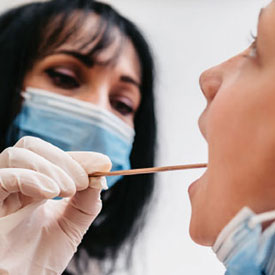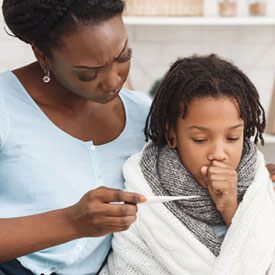Pediatric Provider Research and Education
Brought to you by the Pediatric Antimicrobial Stewardship Program (ASP) Collaborative of the Children’s Health Network of RWJBarnabas Health.
The ASP, representing pediatric providers, including pediatric infectious disease specialists and pharmacists, exchange ideas, discuss case management strategies and develop and implement guidelines to be shared system wide, as well as be a resource for community physicians.
Read more educational information, research and best practices from the Children’s Health Network at RWJBarnabas Health in the near future.
An Essential Primer on Pediatric Infections
Brought to you by the Pediatric Antimicrobial Stewardship Program (ASP) Collaborative of the Children’s Health Network of RWJBarnabas Health.

Pneumococcal Infections and Updates on Pneumococcal Vaccines
Leonard Emuren, MD, MPH, PhD
Division Director, Pediatric Infectious Diseases,
Newark Beth Israel Medical Center
Pneumococcal infections are caused by the bacteria Streptococcus pneumoniae or, simply, pneumococcus. This organism commonly lives in the nose and throat and can be spread by direct contact with respiratory secretions such as mucus or saliva. There are many types of pneumococcal infections or diseases, ranging from mild to severe, depending on the part of the body that is affected. Read more

Meningococcal Disease
Amisha Malhotra, MD
Associate Professor, Department of Pediatrics,
Division of Pediatric Infectious Disease,
Rutgers-Robert Wood Johnson Medical School
Meningococcal disease is a serious illness caused by the bacterium Neisseria meningitidis, which can lead to meningitis and meningococcemia. It’s known for its rapid onset and early symptoms that can be flu-like, with fever, chills, malaise, myalgias, and a characteristic rash that initially can be macular or maculopapular but usually becomes petechial or purpuric within hours. The illness may quickly progress, to include signs/symptoms of meningitis, such as severe headache, neck stiffness, and sensitivity to light. Read more

Blood Cultures
Masako Mizusawa, MD, PhD, MS
Director, Microbiology Center of Excellence, RWJBarnabas Health
Clinical Associate Professor, Department of Pathology and Laboratory Medicine,
Rutgers Robert Wood Johnson Medical School
Mohamed Ellethy, MPH, MLS (ASCP)cm, BS
Center of Excellence Microbiology Manager, Monmouth Medical Center
Blood cultures are essential diagnostic tools in pediatrics, helping to identify the specific bacteria or fungi causing bloodstream infections (BSIs). These infections can be life threatening, and timely diagnosis is crucial. Read more

Pentavalent Meningococcal Vaccine, Penbraya™
Rachel Meyers, PharmD
Pediatric Clinical Pharmacist,
Cooperman Barnabas Medical Center
In October of 2023, the U.S. Food & Drug Administration (FDA) approved Penbraya™, a pentavalent meningococcal vaccine targeted at five serogroups of Neisseria meningitidis (A, B, C, W, and Y). Penbraya™ is approved for patients ages 10 – 25 years of age and is the first meningococcal vaccine to cover five serogroups. Read more

Pertussis
Renuka Verma, MD
Section Chief Pediatric Infectious Disease,
Monmouth Medical Center
Pertussis or whooping cough, begins with mild upper respiratory tract symptoms and progresses to cough, usually paroxysms of cough (paroxysmal stage), characterized by inspiratory whoop (gasping) after repeated cough on the same breath, which commonly is followed by post-tussive emesis. Fever is not common. Symptoms in immunized children and adults are variable. Read more

RSV Updates
Uzma Hasan, MD
Clinical Associate Professor, Rutgers NJ Medical School
Division Director, Pediatric Infectious Diseases,
Cooperman Barnabas Medical Center
Rachel Meyers, PharmD
Pediatric Clinical Pharmacist,
Cooperman Barnabas Medical Center
Jessica Lise, PharmD, BCPPS
Pediatric Clinical Specialist, Department of Pharmacy,
Bristol-Myers Squibb Children’s Hospital at Robert Wood Johnson University Hospital
RSV is a respiratory virus that causes acute respiratory infection in all ages. Read more

Streptococcal Pharyngitis: Do’s and Don’ts
Renuka Verma, MD
Section Chief Pediatric Infectious Disease,
Monmouth Medical Center
Group A strep, Streptococcus pyogenes (GAS) causes infections such as strep throat and impetigo. GAS can cause both noninvasive and invasive disease, as well as non-suppurative sequelae. These bacteria cause approximately 11,000–24,000 cases of severe (invasive) GAS disease, such as necrotizing fasciitis, in the United States each year. Each year, about 1,200– 1,900 people die due to invasive GAS disease. Read more

Emerging Infections
Uzma Hasan, MD
Clinical Associate Professor, Rutgers NJ Medical School
Division Director, Pediatric Infectious Diseases,
Cooperman Barnabas Medical Center
As of Nov 21, 2024, 280 measles cases have been reported from 32 jurisdictions, including 16 outbreaks. Read more

Rising Antibiotic Resistance, With Few New Antibiotics in Development—What Can Pediatricians Do?
Jayshree Kumta, MD
Director, Inpatient Pediatrics,
Newark Beth Israel Medical Center
Amrita Sunkad, MD
Pediatric Resident,
Newark Beth Israel Medical Center
Antibiotic treatment forms an important cornerstone of treatment for infections. The serendipitous discovery of Penicillin in 1928 changed the landscape of treatment and introduced the world to the new and powerful tool of antibiotics. Read more

Mycoplasma Infections on the Rise
Uzma Hasan, MD
Division Director, Pediatric Infectious Diseases
Cooperman Barnabas Medical Center
Mycoplasma pneumoniae is an atypical fastidious organism typically implicated in causing “walking pneumonia”. Bacteria are spread via respiratory droplet inhalation. Infection typically occurs in summer and early fall, but can occur year around. Read more
Triple-demic: What Pediatric Providers Need to Know
Brought to you by the Pediatric Antimicrobial Stewardship Program (ASP) Collaborative of the Children’s Health Network of RWJBarnabas Health.
Influenza Update
Renuka Verma, MD
Section Chief, Pediatric Infectious Diseases,
Unterberg Children’s Hospital at Monmouth Medical Center
Influenza season is upon us and it has shown its ugly head in the pediatric population with significant impact already. Children consistently have the highest attack rates of influenza in the community during seasonal influenza epidemics. Read more

Respiratory Syncitial Virus
Uzma Hasan, MD
Divison Director Pediatric Infectious Diseases,
Cooperman Barnabas Medical Center
Respiratory syncytial virus causes acute respiratory illness in all age groups, with some being impacted more severely than others. It typically causes an upper respiratory infection but can cause lower respiratory tract infection bronchiolitis or pneumonia. Read more

Strep Update
Uzma Hasan, MD
Division Director Pediatric Infectious Diseases,
Cooperman Barnabas Medical Center
Doug DeStefano, PharmD
Corporate AVP, Pharmacy Operations
During the respiratory viral surge, an increase in invasive group A Strep disease is being reported, both in the US and in the UK. The WHO and UK Health Security Agency recently put out an advisory to alert clinicians re: rise in Gp A Strep (Strep Pyogenes infections) including fatalities. Read more

COVID-19 Vaccines for Kids
Amisha Malhotra, MD
Pediatric Infectious Diseases,
Bristol-Myers Squibb Children’s Hospital at Robert Wood Johnson University Hospital,
Associate Professor of Pediatrics at Rutgers-Robert Wood Johnson Medical School
COVID-19 vaccines are recommended by the Centers for Disease Control and Prevention (CDC) for children ages 6 months and older. COVID-19 vaccination protects children against severe disease, including hospitalization. Read more

Amoxicillin Oral Suspension Shortage
Jessica Lise, PharmD, BCPPS
Pediatric Clinical Specialist, Department of Pharmacy,
Bristol-Myers Squibb Children’s Hospital at Robert Wood Johnson University Hospital
Jennifer Sternbach, PharmD, BCPS, BCACP
Assistant Vice President of Clinical Pharmacy Services,
RWJBH Pharmacy
Amoxicillin oral suspension is currently unavailable in all strengths/formulations.
Due to the shortage of amoxicillin suspensions, alternative approaches
must be considered.
Read more
Lyme Disease Primer for Pediatric Providers
Peter Wenger, MD
Attending Physician, Infectious Diseases, Departments of Pediatrics
Children’s Hospital of New Jersey at Newark Beth Israel Medical Center
Cooperman Barnabas Medical Center
We are entering the season local physicians are most likely to encounter patients with Lyme disease. The majority of early localized and early disseminated Lyme disease occur between April and October with over 50% of cases in June and July. Read more


